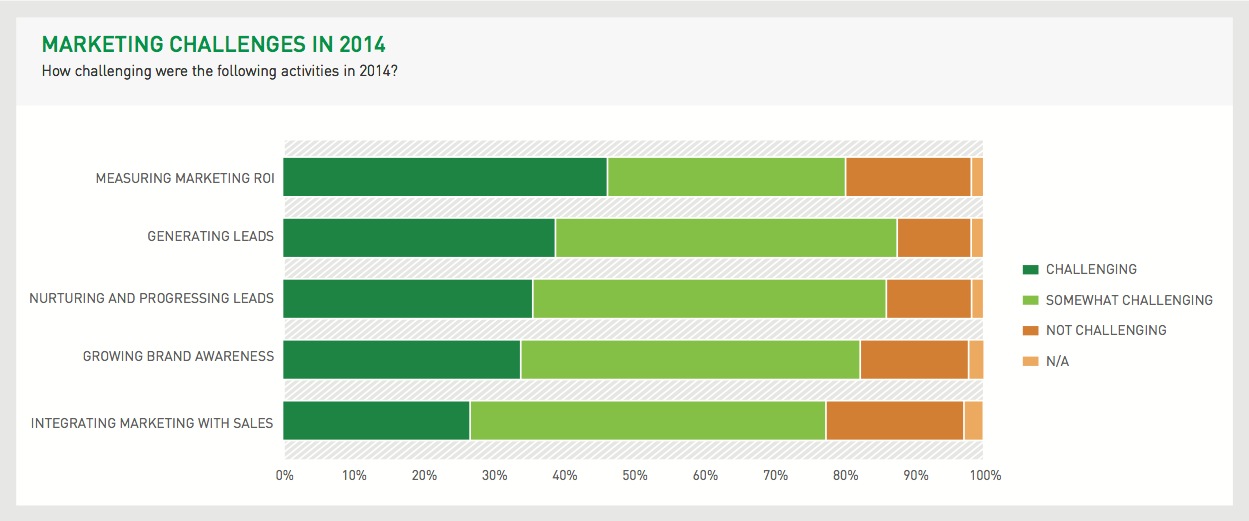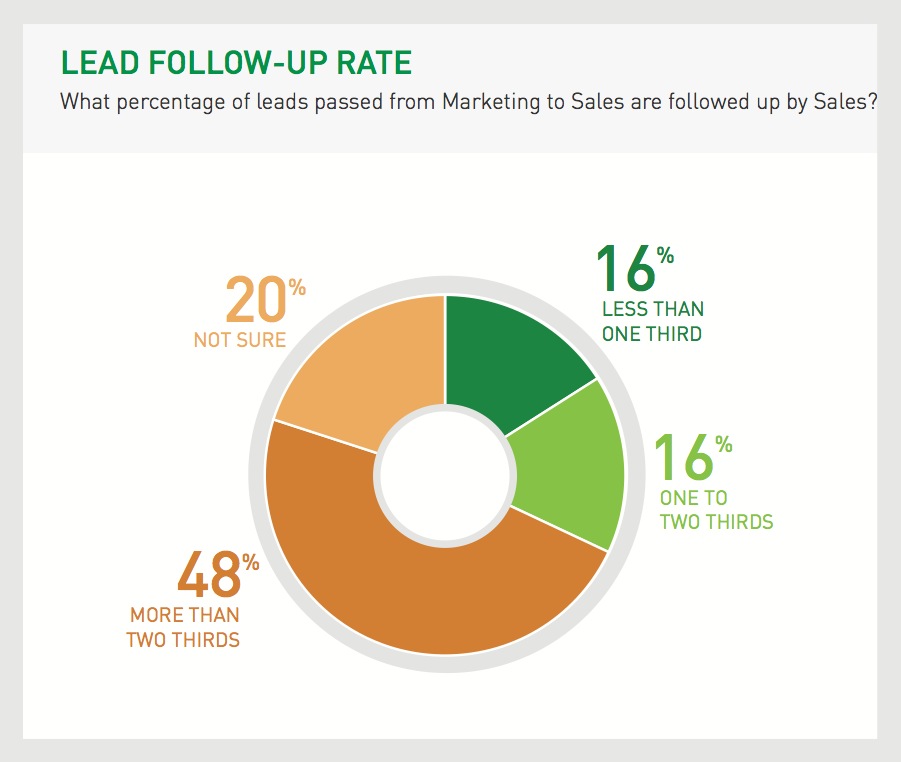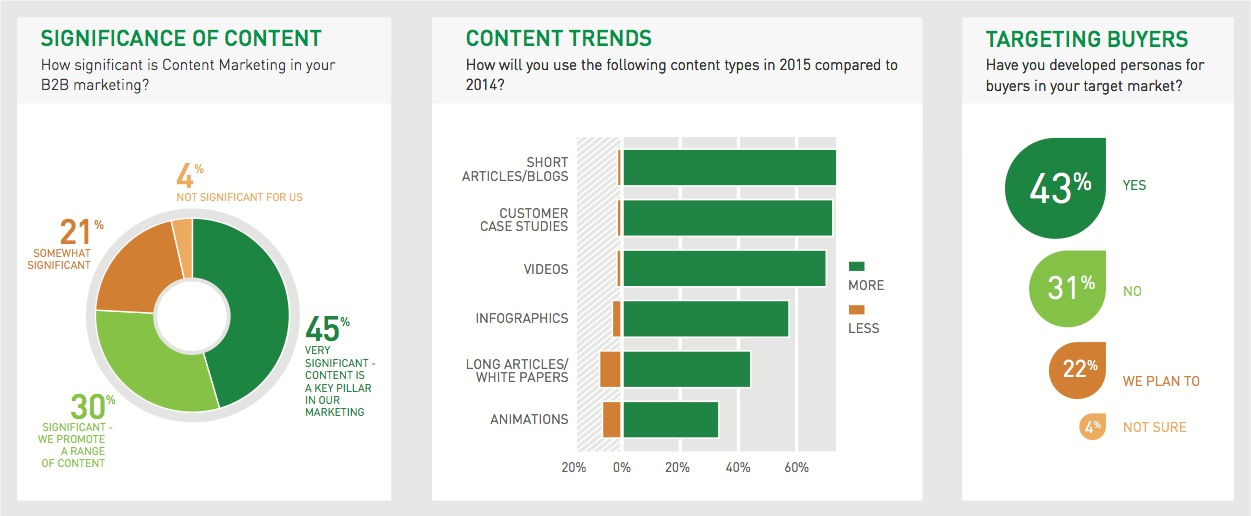Five key trends in B2B marketing – quantified
Share
The fifth annual ‘B2B Marketing Outlook’ study by Green Hat, supported by Marketing, reveals some key messages for business-to-business marketers. Joe Young explores the five key trends with Green Hat’s Andrew Haussegger.
The ecosystem of technology and data in which marketers operate is ever changing and, because this environment is so dynamic, marketers are presented with a range of changing options. This can lead to confusion on which option would provide the best results.
To better understand the changes that are operating within this ecosystem, this article will analyse the ‘B2B Marketing Outlook 2015’ marketing survey carried out by B2B marketing agency Green Hat, in conjunction with ADMA, to look at current attitudes, challenges, opportunities and trends that face marketers today.
The survey, in which 455 marketers participated, showed that the biggest challenge facing marketers in 2015 is measuring ROI. 46% of respondents found it ‘challenging’ and the top marketing objectives are generating leads (81%) and nurturing leads (78%).
Green Hat’s managing director Andrew Haussegger says that over the last few years B2B marketers have been challenged like they have never been before, which has driven them to partake in studies in their thirst for answers.
“You have some more traditional marketers that really aren’t sure how to transition across to being digital and automation,” Haussegger tells Marketing.
Click images to enlarge.
Trend 1: Poor lead follow-up exposes weaknesses in marketing and sales integrations
For Haussegger, the most surprising data to come from the survey was that 52% of respondents have an unsatisfactory outcome with their lead follow-up rate.
In a big step backwards from the 2014 results, only 48% of respondents said at least two-thirds of the leads passed on from marketing to sales are followed up by sales.
“This shows us that there has to be better cohesion between marketing teams and sales teams,” Haussegger says. 43% of respondents said less than a third of leads converted to sales. This indicates that creating better integration between marketing and sales teams is an area of opportunity for companies to improve on those statistics. Green Hat believes the level of lead leakage occurring is due to the absence of a lead lifecycle strategy, ideally developed in unison by the marketing and sales teams.
The loss of potentially large revenue due to this may drive CMOs to carry revenue targets.
Green Hat believes that marketing automation and customer relation management integration are vital for enabling true sales and marketing alignment.
B2B organisations with tightly aligned marketing and sales, achieved 24% faster growth and 27% faster profit growth over a three-year period, according to the US SiriusDecisions Summit 2014.
Trend 2: B2B marketing budgets continue to rise
The Australian economy has been going well lately and the good news for marketers is that marketing budgets are continuing to rise, with 36% of marketing budgets increasing by over 5% in 2015.
“Marketers are slowly getting better at attributing revenue and the success of sales to their work and the more they can prove that they are having a positive impact on the business and showing that they are not just a cost centre, then the more budget they get,” Haussegger says.
“Digital is now on the boardroom agenda, just how culture came on to it 15 years ago. Customers are using digital and the internet to connect with the sellers, so executives are saying we need to be more effective in the online digital space, so that is attracting some budget.
“The senior executives of companies are realising that digital and the internet has to be part of their strategic direction.”
This is apparent in the survey, with digital marketing taking up the largest slice of the marketing budget pie, with 27% of the budget. Traditional offline marketing is on the decline, but still claims second spot with 21% of marketers’ budgets.
Content marketing takes up 17% of the marketing budget, advertising and sponsorship (excluding online) 14%, marketing automation and public relations both 8% and other 5%.
Lead nurturing, social media and email content are digital areas where marketers are willing to spend more. Conversely, print advertising, tradeshows and conferences are areas in which marketers are cutting costs.
Haussegger says this shift from offline to online spending is driven by marketers asking themselves where the buyers are.
“Are they answering their phones? No. Are they reading all their direct mail? No. Are they going to tradeshows more than ever before? No. What are they doing? They’re going online,” Haussegger says.
“Clearly marketers have to go there. It’s a great saying, ‘fish where the fish are’.”
Trend 3: ROI becomes the top challenge for Australia’s B2B marketers
This is the first year marketers have said their biggest challenge is measuring ROI. 46% of respondents said they find it ‘challenging’.
“What has been happening is we have been spending too much time trying to collect our data and then analysing it, and good analytics platforms are going to allow us to not spend all our time just collecting data, but to actually spend more time analysing it and improving things,” Haussegger says.
“I think the next wave is going to be around analytics and predictive data. First, analytics to provide better insight into what’s working and why. That is a key next trend that will start to roll out.”
Green Hat predicts that in 2015/16 marketers will invest more in technology, talent and process re-engineering. According to a study by Millward Brown Digital, more than 70% of marketing executives polled said they would increase their spending on mobile, digital and social platforms if there were better ways to measure ROI.
Trend 4: Content marketing cements status as a key pillar in the mix
In marketing strategy, content marketing has been a big mover in popularity and has now cemented itself as a key pillar in three-quarters of marketing strategies.
Marketers have spent on average 54% more on content marketing year on year.
Social media has been embraced with 64% of marketers now publishing blogs and online content, despite only 11% of marketers saying they had good results from social media marketing in 2014.
Haussegger says that content marketing is becoming very attractive to marketers, because it is all about the buyer. “What has happened now is that the balance of power between the buyer and seller has totally shifted over to the buyer in B2B, so customers can get the bulk of the information that they need through the internet and all their digital circles,” he says. “So what that means is they are spending a whole lot of time going through their buying process before they call the seller. You can find a lot of case studies of people that have the same problem you’ve got and you can even contact them and then they’ll make recommendations on vendors and how to solve it.
“It’s not just content marketing; it’s the combination of a compelling online experience fuelled by content marketing. So one of the pitfalls that we are falling into is we are producing a lot of content, but not effectively distributing and amplifying that content.
“But what they’re not doing well is getting the right content to the right people at the right time, and that’s the challenge.
You can’t do effective content marketing without marketing automation. Automation will do the tracking to decide what content to send next.”
The rise of content marketing driven by the empowered customer has seen marketing budgets tip toward inbound marketing. This year, 41% of marketers are going to spend more money on inbound marketing compared to outbound, as opposed to 25% of marketers who are going to spend more on outbound marketing than inbound. Customers are empowered by the web to research, compare and learn online and are as resistant to push marketing as ever before.
Trend 5: A scientific eclipse of the art
Haussegger believes that marketing is becoming more of a science than an art.
“I think that the traditional people that treated marketing as an art won’t be in their role in a couple of years’ time,” Haussegger says, “a bit like the CMO who doesn’t understand digital in two years time.
“Yes, you have to have a brand and a brand personality, so that hasn’t gone away, but marketers now talk in terms of lead factories, demand generation teams, and they have processes around conversion strategies. These are terms and ideas that people weren’t talking much about five years ago.”
Big challenges this year for marketers are having good integration between marketing teams and sales to capitalise on more leads; and to always look for new and better ways to analyse their data, including predictive data to have a better understanding of their ROI. These are challenges, but also opportunities and, with budgets on the rise, marketers have the scope to achieve these goals in 2015/16.
The ‘B2B Marketing Outlook’ study is an annual survey by B2B marketing agency Green Hat and ADMA exploring B2B marketing practice, intentions and direction. 455 marketing professionals participated in the survey this year. The full report is available free of charge for Pro Members of Marketing Advantage. Click here to find out more about membership.




















